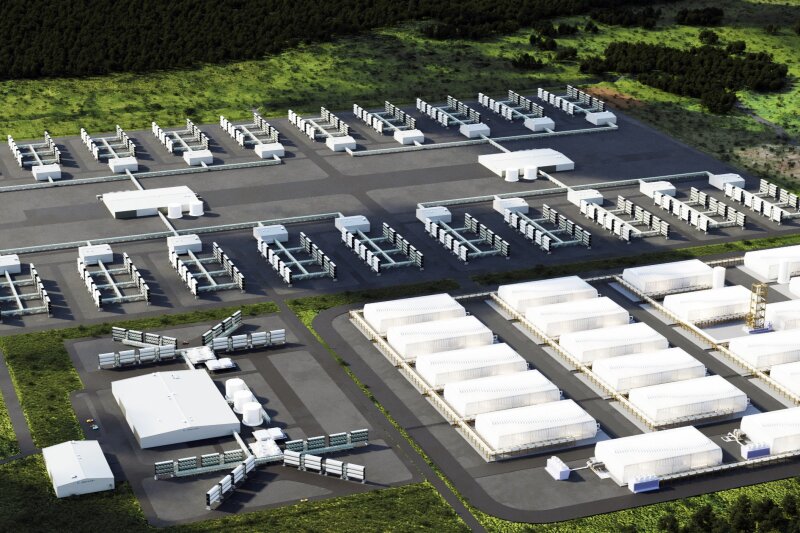Project Cypress, a large direct air capture (DAC) initiative currently under development, was awarded more than $50 million in funding by the US Department of Energy’s Office of Clean Energy Demonstrations (OCED) on 27 March.
According to the OCED, this first tranche of funding is for activities in the initial project phase, which is expected to take from 2 to 3 years and includes planning, design, and community and labor engagement activities.
The funding comes from the Bipartisan Infrastructure Law, and the project is part of the OCED’s Regional Direct Air Capture Hubs program, which seeks to develop four DAC hubs in the US. In August 2023, as part of this program, OCED announced two projects selected for award negotiation: Project Cypress and the South Texas DAC Hub.
Project Cypress is managed by Battelle and with technology partners Heirloom Carbon Technologies and Climeworks. OCED noted that the partners use different approaches to capturing and storing CO2.
While Heirloom utilizes limestone to absorb CO2 as it is repeatedly cycled through heating, hydration, and exposure to air, Climeworks employs a solid-sorbent CO2 capture and thermal-regeneration filter developed by Svante Technologies.
Project Cypress plans to transport the captured CO2 to a sequestration partner which has obtained a permit for permanent geological storage.
Solid-Sorbent Technology

News of the Project Cypress award came a week after Claude Letourneau, president and CEO of Svante, spoke at the CERAWeek by S&P Global conference in March about the future of the CO2 marketplace.
Letourneau described Svante as a pure-play company that is all-in on developing a solution for managing carbon out of industrial emissions.
“In the green industrial transition that needs to happen in parallel to the green energy transition, Svante is looking to manage the CO2 emissions of industries like cement and steel,” he said. We capture the CO2 before it goes out into the atmosphere, concentrate it to 95% pure, and then compress it. Then, a third party would take it and safely store the CO2.”
He added that Svante also removes CO2 from the atmosphere through DAC.
“This is in partnership with the leading company in that space, Climeworks. We are the filter inside that goes into the contactor that goes into their system,” he said. “We're using a unique technology to approach the solution of carbon capture removal, which is a solid-filter approach as opposed to the oil and gas industry using gas-to-liquid solvent to capture CO2.”
Svante was founded in 2007 to capture CO2 from industrial processes and store it safely underground or repurpose it for other applications. The Canadian company developed a compact and cost-effective carbon capture system that uses metal-organic frameworks (MOFs) as solid sorbents for CO2 capture.
These nanoengineered filters are deployed in two ways. For DAC, the filters are assembled into a contactor block and installed into Climeworks’ proprietary DAC stationary contactors.
For industrial point-source carbon capture, Svante’s regenerative moving bed contactors, known as rotary adsorption machines (RAMs), are used. In this application, post-combustion flue gas flows into the RAM, with the filter beds capturing the CO2 and releasing nitrogen into the atmosphere.
Steam is applied to the filter beds to release the pure CO2 from the filter, which is then captured, compressed, and transported for storage. The final stage of the cycle is the cooling and drying of the filter beds. The entire cycle takes 60 seconds to complete.
According to Svante, the RAMs are part of its standardized industrial contactor product, with commercial units available in two sizes. The Ursa 1000 can capture about 182,500 tons of CO2 per year, while the Ursa 2000 can capture about 730,000 tons of CO2 per year.
At the end of 2022, Chevron teamed up with Svante and Kiewit Energy Group to test the technology at industrial scale at its Kern River asset in California’s San Joaquin Valley. The pilot was part of a cooperative agreement (DE-FE0031944) with the US Department of Energy National Energy Technology Laboratory.
The OCED recently selected Delek to negotiate a cost-sharing agreement in support of a large-scale Svante carbon capture pilot project at Delek’s Big Spring refinery in Texas. The program provides 70% cost-sharing for up to $95 million of federal funding to assist with project development.
According to Svante, the project is the first commercial-scale deployment of its solid-sorbent-based filter technology. The system will be situated on-site at Delek US’s Big Spring refinery and connected to the post-combustion flue gas from the fluidized catalytic cracking unit, which is the source of CO2 emissions.
The company is in the final stages of building its commercial filter manufacturing facility in Vancouver, British Columbia, Canada. The center will be equipped to supply both the industrial point-source post-combustion carbon capture market and the DAC market.


